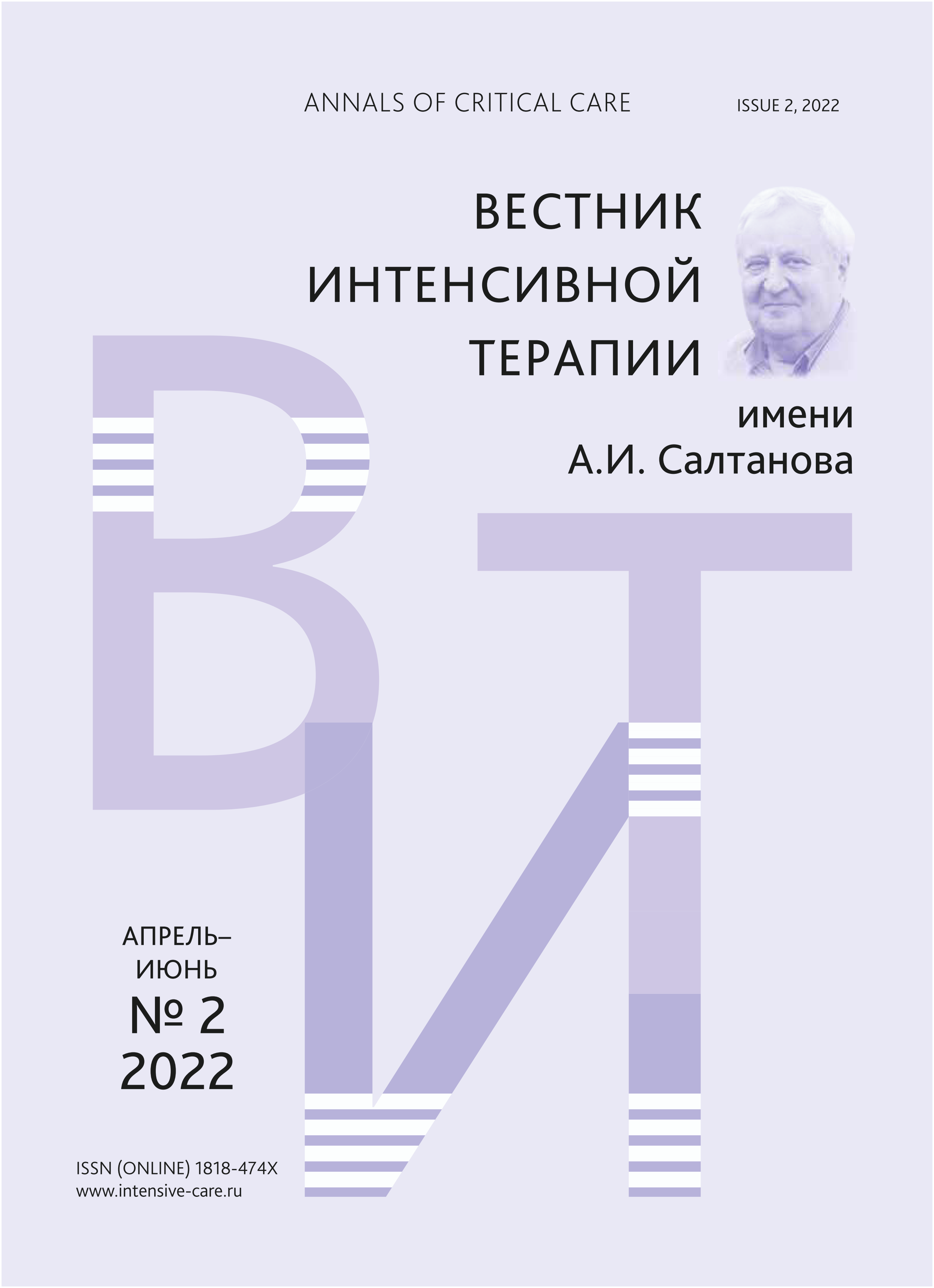Abstract
INTRODUCTION. Rhabdomyolysis (RM) occurs in 40–60 % of patients with acute poisoning and is accompanied by acute kidney injury (AKI). The most effective method of treatment is the use of extracorporeal detoxification. The most promising is the combined methods of detoxification. OBJECTIVES. Improve outcomes in patients with toxic RM complicated by AKI through early use of selective hemosorption and hemodiafiltration. MATERIALS AND METHODS. The study included 57 patients with toxic genesis RM complicated by AKI. The first group received standard intensive therapy. For the treatment of the second group at the early stage of AKI, hemodiafiltration and selective hemoperfusion were used. We performed a comparative analysis of the dynamics of the main clinical and laboratory parameters, as well as treatment outcomes between groups. RESULTS. The use of selective hemoperfusion and hemodiafiltration at the early stage of AKI allowed to increase the decrease in the level of myoglobin in the blood from 26.3 to 88.0 % and KIM-1 in the urine from 76.1 to 99.0 % during the first week of treatment in the ICU (intensive care unit). Combined detoxification reduced the duration of RRT use from 15 to 6 days, which led to a significant decrease in the level of hospital mortality from 14.3 to 6.9 %, the duration of inpatient treatment from 19.5 to 11 days and the period of stay in the ICU from 11 to 4 days. CONCLUSIONS. Early use of combined extracorporeal detoxification leads to a significant decrease in the level of endogenous intoxication factors, which ultimately made it possible to reduce the duration of treatment in the ICU, hospital and reduce the level of hospital mortality.
References
- Petejova N. Martinek A. Acute kidney injury due to rhabdomyolysis and renal replacement therapy: a critical review. Crit Care. 2014; 18(3): DOI:10.1186/cc13897
- Wen Z., Liang Y., Hao Y., et al. Drug-Induced Rhabdomyolysis Atlas (DIRA) for idiosyncratic adverse drug reaction management. Drug Discov Today. 2019; 24(1): 9–15. DOI: 10.1016/j.drudis.2018.06.006
- Bosch X., Poch E., Grau J.M. Rhabdomyolysis and acute kidney injury. N Engl J Med. 2009; 361(1): 62–72. DOI: 10.1056/NEJMra0801327
- Taxbro K., Kahlow H., Wulcan H., Fornarve A. Rhabdomyolysis and acute kidney injury in severe COVID-19 infection. BMJ Case Rep. 2020; 13(9): e237616. Published 2020 Sep 2. DOI:1136/bcr-2020-237616
- Lau Hing Yim C., Wong E.W.W., Jellie L.J., Lim A.K.H. Illicit drug use and acute kidney injury in patients admitted to hospital with rhabdomyolysis. Intern Med J. 2019; 49(10): 1285–92. DOI: 10.1111/imj.14266
- Kwiatkowska M., Chomicka I., Malyszko J. Rhabdomyolysis— induced acute kidney injury — an underestimated problem. Wiad Lek. 2020; 73(11): 2543–8. DOI: 10.36740/WLek202011137
- Хорошилов С.Е. Патогенез, диагностика и эфферентное лечение рабдомиолиза, осложненного острой почечной недостаточностью. Тверской медицинский журнал. [Интернет]. 2017; 5: 45–51. Ссылка: http://tvermedjournal.tvergma.ru/id/eprint/504 [Khoroshilov S.E. Pathogenesis, diagnosis and efferent treatment of rhabdomyolysis complicated by acute renal failure. Tver Medical Journal. [Internet]. 2017; 5: 45–51. Available from: http://tvermedjournal.tvergma.ru/id/eprint/504 (In Russ)]
- Федорова А.А. Рабдомиолиз: что нового в диагностике и лечении? Кремлевская медицина. Клинический вестник. 2020; 2: 102–9. DOI: 10.26269/4n94-0746 [Fedorova A.A. Rhabdomyolysis: What’s New in Diagnosis and Treatment? Kremlin medicine. Clinical Bulletin. 2020; 2: 102–9. DOI: 10.26269/4n94-0746 (In Russ)]
- Ahmad S., Anees M., Elahi I., Fazal-E-Mateen. Rhabdomyolysis Leading to Acute Kidney Injury. J Coll Physicians Surg Pak. 2021; 31(2): 235–7. DOI: 10.29271/jcpsp.2021.02.235
- Dilken O., Ince C., van der Hoven B., et al. Successful Reduction of Creatine Kinase and Myoglobin Levels in Severe Rhabdomyolysis Using Extracorporeal Blood Purification (CytoSorb). Blood Purif. 2020; 49(6): 743–7. DOI: 10.1159/000505899
- Donati G., Cappuccilli M., Di Filippo F., et al. The Use of Supra-Hemodiafiltration in Traumatic Rhabdomyolysis and Acute Kidney Injury: A Case Report. Case Rep Nephrol Dial. 2021; 11(1): 26–35. DOI: 10.1159/000507424
- Weidhase L., de Fallois J., Haußig E., et al. Myoglobin clearance with continuous veno-venous hemodialysis using high cutoff dialyzer versus continuous veno-venous hemodiafiltration using high-flux dialyzer: a prospective randomized controlled trial. Crit Care. 2020; 24(1): 644. DOI: 10.1186/s13054-020-03366-8
- Scharf C., Liebchen U., Paal M., et al. Blood purification with a cytokine adsorber for the elimination of myoglobin in critically ill patients with severe rhabdomyolysis. Crit. Care. 2021; 25(1): 41. DOI: 10.1186/s13054-021-03468-x
- Naka T., Jones D., Baldwin I., et al. Myoglobin clearance by super high-flux hemofiltration in a case of severe rhabdomyolysis: a case report. Crit. Care. 2005; 9(2): 90–5. DOI: 10.1186/cc3034
- Zhang L., Kang Y., Fu P., et al. Myoglobin clearance by continuous venous-venous haemofiltration in rhabdomyolysis with acute kidney injury: a case series. Injury. 2012; 43(5): 619–23. DOI: 10.1016/j.injury.2010.08.031
- Mikkelsen T.S., Toft P. Prognostic value, kinetics and effect of CVVHDF on serum of the myoglobin and creatine kinase in critically ill patients with rhabdomyolysis. Acta Anaesthesiol Scand. 2005; 49(6): 859–64. DOI: 10.1111/j.1399-6576.2005.00577.x
- Ankawi G., Xie Y., Yang B., et al. What Have We Learned about the Use of Cytosorb Adsorption Columns? Blood Purif. 2019; 48(3): 196–202. DOI: 10.1159/000500013
- Schrezenmeier E.V., Barasch J., Budde K., et al. Biomarkers in acute kidney injury – pathophysiological basis and clinical performance. Acta Physiol (Oxf). 2017; 219(3): 554–72. DOI: 10.1111/apha.12764
- Pasala S., Carmody J.B. How to use… serum creatinine, cystatin C and GFR. Arch Dis Child Educ Pract Ed. 2017; 102(1): 37–43. DOI: 10.1136/archdischild-2016-311062
- Oshima Y. Characteristics of drug-associated rhabdomyolysis: analysis of 8,610 cases reported to the U.S. Food and Drug Administration. Intern Med. 2011; 50(8): 845–53. DOI: 10.2169/internalmedicine.50.4484
- Esposito P., Estienne L., Serpieri N., et al. Rhabdomyolysis-Associated Acute Kidney Injury. Am J Kidney Dis. 2018; 71(6): A12–A14. DOI: 10.1053/j.ajkd.2018.03.009

This work is licensed under a Creative Commons Attribution-NonCommercial-ShareAlike 4.0 International License.
Copyright (c) 2022 ANNALS OF CRITICAL CARE

